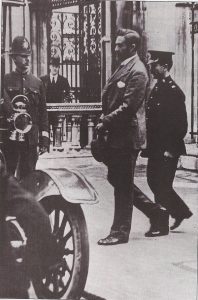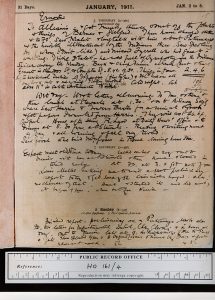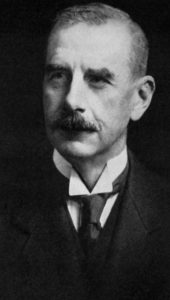REVISION: Casement tried and tested—the Giles Report on the Black Diaries
Published in 20th-century / Contemporary History, Features, Issue 4 (July/August 2016), Volume 24A VERBAL SMOKESCREEN OF AMBIGUITY, REPETITIONS, IRRELEVANT DATA, DECEPTIONS, OMISSIONS, EX CATHEDRA PRONOUNCEMENTS AND DISINFORMATION
By Paul Hyde
The results of the 1959 test cannot be found; the 1972 test was amateurish; the 1993 test was inconclusive. Then in 2002 the Giles Laboratory was commissioned by Professor W.J. McCormack to examine the controversial diaries and subsequently declared them authentic. In the years since, work on Casement has progressed, and different questions might now be asked of the McCormack–Giles intervention.
The initial proposition given to document examiner Dr Audrey Giles was that she authenticate the questioned documents: ‘The Steering Group have set the initial proposition to be that the documents at Kew known collectively as Roger Casement’s Black Diaries are genuinely written in his hand throughout’. This instruction is fundamentally biased and compromises both examiner and the subsequent examination. For this reason alone the report would not have been accepted by any court of law.
![Above: The five Black Diaries—1 (centre), the Army Book, a small field service notebook [Feb. & July 1902]; 2 (from left to right), Lett’s Pocket Diary & Almanac [Feb. 1903–Jan. 1904]; 3, Dollard’s Office Diary for 1910; 4, Charles Lett’s Popular Desk Diary 1911; 5, Cash Leger [1910 & 1911]. (UKNA)](https://www.historyireland.com/wp-content/uploads/2016/07/The-Black-Diaries.jpg)
Above: The five Black Diaries—1 (centre), the Army Book, a small field service notebook [Feb. & July 1902]; 2 (from left to right), Lett’s Pocket Diary & Almanac [Feb. 1903–Jan. 1904]; 3, Dollard’s Office Diary for 1910; 4, Charles Lett’s Popular Desk Diary 1911; 5, Cash Leger [1910 & 1911]. (UKNA)
Scientific investigation seeks falsification, not verification
Dr Giles should have pointed out the limitations of handwriting examination and that it might be impossible to reach a definitive conclusion. Having accepted the commission, she proceeded to authenticate the documents. But it is axiomatic that scientific investigation seeks falsification, not verification. The dominant paradigm is tested by looking for weaknesses, contradictions, anomalies. Therefore the Giles investigation cannot claim scientific validity because it started from compromised premises.Further, the report does not fulfil the requirements of a forensic report to be demonstrated in a court of law because it lacks scientific detail, definitions and clear parameters. Quite simply, the conclusion is not demonstrated. Furthermore, there is an astonishing statement by Dr Giles confirming that certain tests were not carried out because she had already foreseen the results of those tests without performing them. She stated in RTÉ’s March 2002 Alan Gilsenan documentary, The Ghost of Roger Casement:
‘We could go ahead and carry out analysis of the inks, there are some problems there. There has to be a recognition that if indeed the Diaries are substantial forgeries, then they would have been produced at about the same time as the documents are dated or not long afterwards. So they are going to be produced using materials of the age, so I doubt whether in the end any close analysis of the ink is going to tell us a great deal about them.’
This statement alone is sufficient to convince the ‘forgery theorists’ that the Giles/McCormack enterprise was planned as a media event rather than an impartial scientific investigation. It perfectly demonstrates the error of seeking verification rather than falsification of a thesis: the examiner uses only those tests and methods that will produce the desired result. In this case the methods used were those of comparative handwriting analysis, which, by Dr Giles’s own admission, are subjective:
‘Handwriting examinations are necessarily to some extent subjective. It relies on my judgement to determine whether features are the same or different.’

Above: Roger Casement leaving court after the appeal against his conviction had been dismissed. (Daily Mirror Picture Library)
The report was peer-reviewed by US document examiner James Horan:
‘As editor of the Journal of Forensic Sciences and the Journal of the American Society of Questioned Document Examiners, I would NOT recommend publication of the Giles Report because the report does not show HOW its conclusion was reached.To the question, “Is the writing Roger Casement’s?”, on the basis of the Giles Report as it stands, my answer would have to be I cannot tell.’
Nevertheless, the media campaign proved successful not only in perpetuating the official thesis of authenticity but also in regenerating that untested thesis as definitively proven. Doubters became heretics as scientific investigation became propaganda.
Cognitive bias
Leading US experts, including Andrew Sulner (Fellow of the American Academy of Forensic Sciences, lawyer and former state prosecutor) and Professor Dan Simon, have explored cognitive bias and flawed forensics. Sulner has pointed out that too many handwriting experts still believe that training and experience shield them from the biasing influences proven to impact the accuracy of visual observations and decision-making by ordinary mortals. In his paper ‘Cognitive and motivational causes of investigative error’, presented to the American Academy, Professor Simon explained how errors can compound with each other and demonstrated various dangers in forensic investigations, such as selective framing(the inquiry is framed in terms designed to influence the outcome), selective exposure (the information provided is chosen to influence the outcome) and selective stopping (the inquiry ends when the hypothesis appears to be confirmed). The Giles Report is afflicted by all three defects.
It is now increasingly recognised in the US forensic science community that experts are reluctant to acknowledge the possibility of mental contamination of evidence in the form of cognitively biased evaluations. As highlighted in the 2009 National Academies of Science report Strengthening forensic science in the US, research in behavioural science and information obtained from reviews of errors in high-profile cases have clearly established the adverse impact that contextual and motivational biases have on human judgement and on the accuracy of forensic evaluations of evidence.
Scrutiny
Deep scrutiny exposes the following lethal defects in the Giles Report.Firstly, whereas document examiners do use the term ‘consistent with’ despite its lack of precision, ‘consistent with’ says no more than ‘might be’ owing to a degree of observed similarity. But an imprecise degree of similarity is insufficient forpositive identification and therefore is inconclusive.
A series of ‘consistent with’ results is more persuasive than one or two such results because the apparently repeated similarity suggests lower probability of error in each observation. It does not, however, guarantee error elimination—the key word is ‘suggests’. It is here that cognitive bias plays a determining role by unconsciously programming the search for repeated similarity. The subjective perceptive mechanism becomes less impartial as it is progressively conditioned by a cognitive bias created by previous observations; we see what we have been previously conditioned to see. The process is called recognition.
Dr Giles reaches ‘conclusive’ evidence by repeating the expression ‘if taken together’ in the preambles to her conclusions; this expression, following the imprecise ‘consistent with’, overlooks the distinct features of single contentious entries. A number of ‘consistent with’ assertions grouped under ‘if taken together’ produce what she calls ‘conclusive evidence’. But ‘consistent with’ is not a constituent of conclusive evidence because it is an intermediate term on the scale of value determination; any number of identical inconclusive terms cannot produce a conclusive result.
This is a misapplication of the Law of Large Numbers, which requires variant input values in order to produce a result higher than some of the input values: 2+3+4+5 divided by 4 = 3.5, which is higher than two of the input values,but 3+3+3+3 divided by 4 = 3, which is identical to all input values. Therefore a series of ‘consistent with’ input values cannot produce a result higher than any single input value. Identical inconclusive values cannot produce conclusive results. The final Giles conclusion ought to be ‘consistent with’, which is inconclusive. This outcome would be ‘consistent with’ the 1993 result of ‘correspond closely’.
Secondly, the term ‘consistent pattern’ appears on six different occasions in the report. What is meant by ‘consistent pattern’ goes unexplained, however, but it clearly refers to the ‘contentious entries’. Regarding the possibility of forged entries, Dr Giles states: ‘… I would expect to find evidence of this in the form of a consistent pattern of contentious entries’. Without an explanation, one must guess at possible meanings. Does she mean that the contentious entries should show features that distinguish them as a group from innocuous writings? Does she expect the questioned writings to be labelled for easy identification? If they were easy to identify by virtue of shared distinctive features, then the hypothetical forger would have utterly failed. Dr Giles does not even explain why she would expect to find any pattern. Surely a repeated detectable pattern acts like a label and is exactly what the forger would avoid?
At another point, she discusses the difficulty of simulating another person’s handwriting owing to the need to suppress the writer’s own handwriting during simulation. ‘Whereas this may be done over a small portion of handwriting, this becomes extremely difficult over more than a few lines of handwriting.’ But is she referring to a beginner or to an experienced forger? Noone disputes that the writings, if forged, were done by an expert. But even this misses the point. The fact is that the contentious entries are all relatively brief. Dr Giles states many times that the entries are ‘restricted in quantity’, ‘limited quantities of comparable material’, ‘the contentious entries represent a small amount of comparable material’. The contentious entries never amount to ‘more than a few lines of handwriting’—frequently much less. Thus this brevity facilitates the experienced forger, who never needs to simulate extended handwriting such as a letter might contain.

Above: The 1911 Lett’s Diary, 5–8 January, which, according toDr Giles, contains contentious writings ‘on virtually every page … It is easier to identifyareas where the entries are non-contentious rather than where they are contentious’. No explanation is given for this easier distinction. (UKNA)
In her quest to provide another form of ‘proof’, Dr Giles explains that special instruments were used to detect alterations, deletions and erasures. On two separate occasions she states that limited testing for erasures was done on blank pages and no evidence was found. The tests were limited because ‘unfortunately, without some manipulation, the Diary pages cannot be subjected to ESDA (Electrostatic Detection Apparatus) examination’. On a separate occasion, the erasure test is again performed on blank pages; again these pages ‘are not suitable for’ the ESDA technique. No evidence was found. Therefore limited erasure tests were applied only to pages without writing and by chance those blank pages—and only those—were unsuited to ESDA testing. No erasure tests were done on any written pages to detect suspected interpolation of contentious writing.

Above: The 1911 Lett’s Diary, 5–8 January, which, according toDr Giles, contains contentious writings ‘on virtually every page … It is easier to identifyareas where the entries are non-contentious rather than where they are contentious’. No explanation is given for this easier distinction. (UKNA)
Does the Giles Report actually demonstrate the falsity of its own conclusions? Instead of lucid exposition, what precedes the conclusion is a verbal smokescreen composed of ambiguity, repetitions, irrelevant data, deceptions, omissions, ex cathedra pronouncements and disinformation. A century on from their miraculous appearance, the provenance of the Black Diaries has not been determined. The release of the ‘discovery’ document (MEPO 2/10672) in 2001 after 85 years of secrecy met with ominous silence. This police list of personal effects allegedly found in Casement’s trunks, date-stamped 28 July 1916, adds one more version to Thomson’s four conflicting versions and to that recorded in the interrogation transcript. The Giles Report, despite its scientific veneer, cannot eliminate the fact that there are now six versions of discovery of the diaries. That a single credible account of the provenance of the crucial documents cannot be produced after 100 years reveals dangerous instability in the foundations of the authenticity edifice.
Paul Hyde is a retired university lecturer.
FURTHER READING
Mary E. Daly (ed.), Roger Casement in Irish and world history (Dublin, 2005).
P. Hyde, ‘Lost to history: an assessment and review of the Casement Black Diaries’, https://breac.nd.edu/articles/65746-lost-to-history-an-assessment-and-review-of-the-casement-black-diaries/.
















